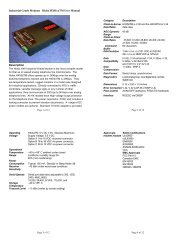Create successful ePaper yourself
Turn your PDF publications into a flip-book with our unique Google optimized e-Paper software.
<strong>AT</strong> <strong>Commands</strong> <strong>Reference</strong> <strong>Manual</strong><br />
2.2.2 Command Line Editing<br />
The character defined by parameter S5 (default, BS) is interpreted as a request from the<br />
DTE to the modem to delete the previous character. Any control characters (IA5 0/0<br />
through 1/15, inclusive) that remain in the command line after receipt of the termination<br />
character are ignored by the modem.<br />
The modem checks characters from the DTE first to see if they match the termination<br />
character (S3), then the editing character (S5), before checking for other characters. This<br />
ensures that these characters will be properly recognized even if they are set to values<br />
that the modem uses for other purposes. If S3 and S5 are set to the same value, a<br />
matching character will be treated as matching S3 (S3 is checked before S5).<br />
2.2.3 Command Line Echo<br />
The modem may echo characters received from the DTE during command state and<br />
online command state back to the DTE, depending on the setting of the E command. If<br />
enabled, characters received from the DTE are echoed in the same format as received.<br />
Invalid characters in the command line or incomplete or improperly-formed command<br />
line prefixes may not be echoed.<br />
2.2.4 Repeating a Command Line<br />
If the prefix "A/" or "a/" is received, the modem immediately executes once again the<br />
body of the preceding command line. No editing is possible, and no termination character<br />
is necessary. A command line may be repeated multiple times in this manner. Responses<br />
to the repeated command line are issued using format of the original command line. If<br />
"A/" is received before any command line has been executed, the preceding command<br />
line is assumed to have been empty (that results in an OK result code).<br />
2.2.5 Types of DTE <strong>Commands</strong><br />
There are two types of commands: action commands and parameter commands.<br />
<strong>Commands</strong> of either type may be included in command lines, in any order.<br />
Action commands may be "executed" (to invoke a particular function of the equipment,<br />
which generally involves more than the simple storage of a value for later use), or<br />
"tested" (to determine whether or not the equipment implements the action command,<br />
and, if subparameters are associated with the action, the ranges of subparameter values<br />
that are supported).<br />
Parameters may be "set" (to store a value or values for later use), "read" (to determine the<br />
current value or values stored), or "tested" (to determine whether or not the equipment<br />
implements the parameter, and the ranges of values supported).<br />
2.3 Basic Syntax <strong>Commands</strong><br />
2.3.1 Basic Syntax Command Format<br />
The format of Basic Syntax commands, except for the D and S commands, is as follows:<br />
[]<br />
2-2<br />
Conexant<br />
100722B








